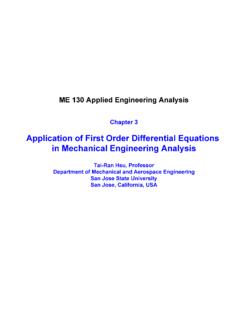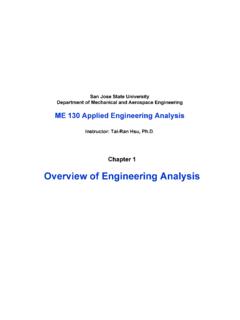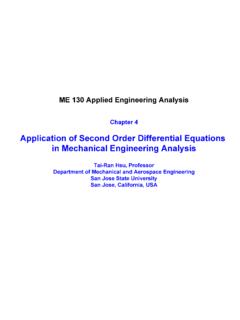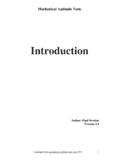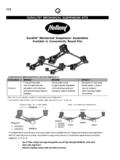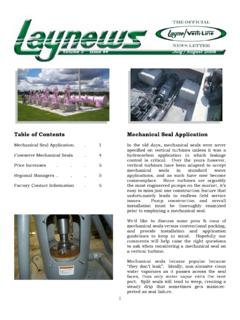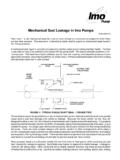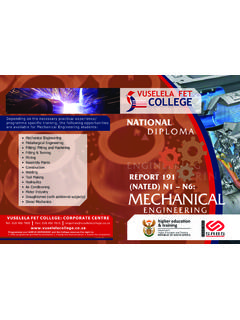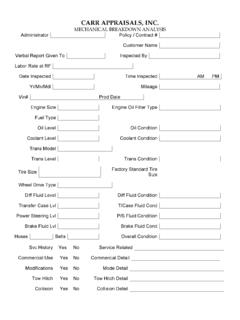Transcription of Application of Second Order Differential Equations …
1 Chapter 4 Application of Second Order Differential Equations in mechanical Engineering AnalysisTai-Ran Hsu, ProfessorDepartment of mechanical and Aerospace EngineeringSan Jose State UniversitySan Jose, California, USAME 130 Applied Engineering AnalysisChapter Outlines Review solution method of Second Order , homogeneous ordinary Differential Equations applications in free vibration analysis- Simple mass-spring system- Damped mass-spring system Review solution method of Second Order , non-homogeneous ordinary Differential Equations - applications in forced vibration analysis- Resonant vibration analysis- Near resonant vibration analysis Modal analysis Part 1 Review Solution Method of Second Order , Homogeneous Ordinary Differential EquationsTypical form0)()()(22=++xbudxxduadxxud( )where a and b in Equation ( ) are constantsThe solution of Equation ( ) u(x) may be obtained by ASSUMING:u(x) = emx( )in which m= constantto be determinedIf the assumed solution u(x) in Equation ( ) is valid solution, it must SATISFY theDE in Equation ( ).
2 That is:()()()022=++mxmxmxebdxedadxedBecause: ()mxmxemdxed222=()mxmxmedxed=and(a)Upon substitution of the above into Equation (a) leading to:()()02=++mxmxmxebemaemBecause emxin the expression cannot be zero (why?), we thus have:m2 + am + b = 0( )Equation ( ) is a quadratic equation, and its solution for m are:m2+ am + b = 0 The quadratic equation:The TWO roots of the above quadratic equation have the forms:baamandbaam421242122221 = + =( )This leads to two possible solutions for the function u(x) in Equation ( ):()xmxmececxu2121+=( )where c1and c2are the TWOarbitrary constants to be determined by TWO specified conditions, and m1and m2are expressed in Equation ( )Because the constant coefficients a and b in Equation ( ) are fixed with the DE, the relative magnitudes of the a, bwill result in significant forms in the solution in Equation ( ) due to the square root parts in the expression of m1and m2in Equation ( ).
3 Square root of a negative number will lead to a complex number in the solution of the DE, which requires a special way of expressing thus need to look into 3 possible casesinvolving relative magnitudes a and 4b > 0:In such case, we realize that both m1and m2 are real numbers. The solution of the Equation ( ) is:( )Case 4b < 0:As described earlier, both these roots become complex numbers involving imaginary parts. The substitution of the m1and m2into Equation ( ) will lead to the following:( )in which . The complex form of the solution in Equation ( ) is not always easily comprehended and manipulative in engineering analyses, a more commonly used form involving trigonometric functions are used:( )where A and B are arbitrary expression in Equation ( ) may be derived from Equation ( ) using the Biot relationthat has the form.
4 += 2/422/41222)(xbaxbaaxececexu += 224224212)(abixabixaxececexu1 =i + = xabCosBxabSinAexuax222421421)( SiniCosei = Case = 0:Recall Equation ( ):baamandbaam421242122221 = + =The condition a2 4b = 0 will lead to a situation: m1= m2= a/2 Substituting the m1 and m2 into Equation ( ) will result in: xaxacexuoreccxu21221)()()( =+=with only ONEterm with a constant in the solution, which is not complete for a 2ndorder , we will have to find the missing termin the solution u(x).Realizing the fact that the assumed solution u(x) = emxin Equation ( ) results in onemissing term, we need to find another assumed solution. Let us try the following:u2(x) = V(x) emx( )where V(x)is a function of x, and it needs to be determinedWe may follow the same procedure before in determining function V(x), that is theassumed Second solution of Equation ( ) must satisfy Equation ( )(b)0)()()(22=++xbudxxduadxxudThe DE:The assumed Second solution: u2(x) = V(x) emxWe must have:()[]()[]()[]022=++mxmxmxexVbdxexVda dxexVdOne would find:()[]()()dxxdVeexmVdxexVdmxmxmx+=and ()[]()()()()2222dxxVdedxxdVmedxxdVeexmVm dxexVdmxmxmxmxmx++ +=(c)After substituting the above expressions into Equation (c), we get:()0)()()2()(222=+++++xVbammdxxdVamdx xVd( )Since m2 + am + b = 0 in Equation ( ), and m = m1= m2= a/2 in Equation (b),0)(22=dxxVdboth 2ndand 3rdterm in Equation ( ) drop out.
5 We thus only have the first term toconsider in the following special form of 2ndorder DE:( )The solution of DE in Equation ( ) is:V(x) = xThe solution V(x) = x leads to the Second solution of the DE0)()()(22=++xbudxxduadxxudin Case 3 with a2 4b = 0as:()22)(axmxmxxexeexVxu ===The complete solution of the DE in this case thus becomes:u(x) = u1(x) + u2(x)or()2212221)(axaxaxexccexcecxu +=+=( )Summary on Solutions of 2ndOrder HomogeneousDEsThe equation:0)()()(22=++xbudxxduadxxud( )with TWOgiven conditionsCase 1: a2 4b > 0: += 2/422/41222)(xbaxbaaxececexu( )Case 2: a2- 4b < 0: + = xabCosBxabSinAexuax222421421)(( )Case 3: a2 - 4b = 0:()2212221)(axaxaxexccexcecxu +=+=( )The solutionswhere c1, c2, Aand Bare arbitrary constants to be determined by given conditionsA special caseExample the following Differential equation ( ):(a)Solution:We have a = 5 and b = 6, by comparing Equation (a) with the typical DE in Equation ( ).
6 This will lead to:a2 4b = 52-4x6 = 25 24 = 1 > 0 - a Case 1 situation with 0)(6)(5)(22=++xudxxdudxxudConsequently, we may use the standard solution in Equation ( ) to be: += 2/422/41222)(xbaxbaaxececexuor1142== ba()()xxxxxececececexu32212/22/12/5 +=+=where c1and c2are arbitrary constants to be determined by given conditionsExample the following equation with given conditions (p. 84):0)(9)(6)(22=++xudxxdudxxud(a)with given conditions:u(0) = 2 (b)and0)(0==xdxxdu(c)Solution:Again by comparing Equation (a) with the typical DE in Equation ( ), we have: a = 6 and b = examining a2 4b = 62 4x9 = 36 36 = 0, leading to special Case 3 in Equation ( ) forthe solution:()2212221)(axaxaxexccexcecxu +=+=or ()()xxexccexccxu3212621)( +=+=( )(d)Use Equation (b) for Equation (d) will yield c1= 2, leading to: ()()xexcxu322 +=Differentiating Equation (e) with condition in Equation will lead to the following manipulation:(e)()() ( )[]06232023230= =+ == =cxcecedxxduxxxxSo, we solve for c2 = 6 Hence the complete solution of Equation (a) is.
7 ()xexxu3312)( += Application of 2nd Order Homogeneous DEs for mechanical Vibration AnalysisPart 2 mechanical vibration is a form of oscillatory motionof a solid or solid structure of a Sources of mechanical Vibrations:(1) Time-varying mechanical force or pressure.(2) Fluid induced vibration ( intermittent wind, tidal waves, etc.)(3) Acoustics and ultrasonic.(4) Random movements of supports, seismic(5) Thermal, magnetic, types of mechanical Vibrations:0 Time, tAmplitudesPeriod(1) With constant amplitudes and frequencies:0 Time, tAmplitudePeriod(2) With variable amplitudes but constant frequencies0 Time, tAmplitude(3) With random amplitudes and frequencies: mechanical vibrations, in the design of mechanical systems, is normally undesirable occurrence, and engineers would attempt to either reduce it to the minimum appearance, or eliminate it completely.
8 Vibration Isolators are commonly designed and used to minimize vibration of mechanicalsystems, such as:Design of vibration isolators requires analyses to quantify the amplitudes and periodsof the vibratory motion of the mechanical system a process called mechanical vibration analysis Benches for high-precision instrumentsVibration isolatorsSuspension of heavy-duty truckVibration isolatorsThe three types of mechanical vibration analyses by mechanical engineers:A. Free vibration analysis:The mechanical system (or a machine) is set to vibrate from its initial equilibrium conditionby an initial instantaneous disturbance (either in the form of a force or a displacement). this disturbance does not exist while the machine is are two types of free vibrations:MassSprings Damped vibration system:MassSpring &DamperB.
9 Forced vibration analysis:Vibration of the mechanical system is induced by cyclic loading at all times. Simple mass-spring system:MassMechanical vibration requires: Mass, spring force (elasticity), damping factor and initiatorC. Modal analysisTo identify natural frequencies of a solid machine at various modes of vibrationPhysical Modeling of mechanical VibrationsThe simplest modelfor mechanical vibration analysis is a MASS-SPRING system: MassmMassmkkwith m = mass, and k = spring constant k is defined as the amount of force required to deflect a certain amount of the spring = F/ So, k has a unit of lbf/in or N/m k is a propertyof a given springApplied forceFInducedDeflection The spring in this system is to support the mass Springs in the system need not to be coil springs Any ELASTIC solid support can be viewed as a spring =MassSpring:Cableor rodMassSpring:Elastic beamSprings:Support StructureMasses.
10 Masses of thebridge structureSimple Mass-Spring SystemsComplex SystemSimple Mass-Spring Systems in Free VibrationThe physical phenomenaof solids in free vibrationis that the vibration of solid is produced by an instantaneous disturbanceeither in the form of a force or deformationof the supporting initial disturbance does not existafter the vibration of the solidsMassmMassmkkIt takes a MASSand SPRING(or elastic) supportto get the vibration of the mass goingMassmSpring ConstantkMotionDisturbance causes vibration of the massMassmkkhMassmk-y(t)+y(t)Stretching of Spring at t is:h + y(t)(a) Free-hung spring(b) Statically stretchedspring(c) A vibrating mass at time tMathematical Formulation of Simple Mass-Spring Systems in Free VibrationMassmMassmkkAs we said it before: It takes a MASSand a SPRING(or elastic) support to get the vibration of the mass , the simplest physical model for a mechanical vibration system is like what is shownPhysical Model for Mathematical Formulation(1) Begins with:(2) The free-hung spring deflectsupon attaching a mass m:(3)A small instantaneous push-down is applied to the massand release quickly.
